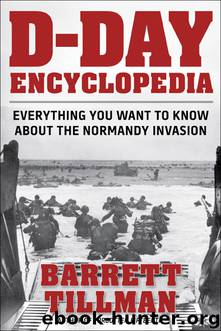D-Day Encyclopedia: Everything You Want to Know About the Normandy Invasion by Barrett Tillman

Author:Barrett Tillman [Tillman, Barrett]
Format: epub
ISBN: 9781621573128
Publisher: Perseus Books, LLC
Published: 2016-01-06T16:00:00+00:00
LCVP: U.S. Army via Martin K.A. Morgan.
Landing Craft, Assault (LCA)
The British variant of the Higgins Boat (LCVP) differed primarily from the U.S. design in being lightly armored. Consequently, the LCA was heavier than its American counterpart and sat lower in the water. The Royal Navy had 646 in Britain during early June 1944. The U.S. Navy reported seventeen LCA (Utility) craft destroyed off Normandy prior to the major storm of 17–18 June.
Landing Craft, Control (LCC)
The volume of offshore traffic anticipated at Normandy led to construction of control landing craft to direct amphibious forces to the proper beaches. Somewhat larger than an LCVP, the LCC had a deckhouse and multiple radio antennas to perform its mission as a navigational leader. On D-Day few American landing craft reached shore in their planned sectors owing to strong currents and to the particular confusion at Omaha Beach. However, sector commanders in LCCs were able to improvise in many cases, directing LCVPs, LCIs, and other craft to suitable landing areas.
Landing Craft, Infantry (LCI)
Largest of the troop transport craft, “Elsie Items” were 160 feet long, displacing some 385 tons and capable of fifteen knots. They carried almost two hundred fully armed troops, the equivalent of an infantry company or more, debarked by catwalks that lowered from either side of the bow. Other variants were LCI(G)s, heavily armed gunboats with 20 and 40 mm weapons as well as three-inch cannon. LCI(M)s were equipped with heavy 4.2-inch mortars in addition to 20 and 40 mm guns, while LCI(R)s were mainly employed in the Pacific, with five-inch rocket launchers. One soldier who crossed the English Channel in an LCI said that in a seaway it combined the movements of a roller coaster, bucking bronco, and a camel.
Neptune-Overlord involved 247 LCIs, evenly distributed between U.S. and Royal Navy units. U.S. Navy losses included nine LCIs during the landings. Nearly a hundred were listed in the Mediterranean and 128 with American forces in the Pacific Theater of Operations.
Landing Craft, Mechanized (LCM)
Powered by three 225 hp diesels, LCMs could make ten knots en route to the beach. They were the largest craft normally carried by attack transports, each capable of carrying 120 men, a medium tank, or thirty tons of cargo. The common variant was the fifty-foot Mark III, which was equipped with winches and anchors to back itself off the beach for a return trip to its transport. Eight U.S. LCMs were lost off Normandy.
In all, 486 LCMs were committed to Operation Neptune, including 358 of the LCM-3 version. The total was almost evenly divided between the U.S. and British navies. Additionally, the U.S. Navy counted almost 1,200 LCMs in the Pacific Fleet, while the Allies listed 280 in the Mediterranean.
Landing Craft, Support (LCS)
These specially configured craft were equipped to provide fire support to assault troops crossing the beach. LCS craft came in different sizes, designated LCS(L) and LCS(S), for large or small. The most common variant was thirty-six feet long, capable of taking guns or rockets close to shore, where it could help suppress enemy fire.
Download
This site does not store any files on its server. We only index and link to content provided by other sites. Please contact the content providers to delete copyright contents if any and email us, we'll remove relevant links or contents immediately.
Periodization Training for Sports by Tudor Bompa(7324)
The MacArthur Bible Commentary by John MacArthur(4231)
The Body: A Guide for Occupants by Bill Bryson(3791)
The Sports Rules Book by Human Kinetics(3582)
What It Really Takes to Get Into Ivy League and Other Highly Selective Colleges by Hughes Chuck(3217)
Marijuana Grower's Handbook by Ed Rosenthal(3114)
The Sprouting Book by Ann Wigmore(3050)
Salt, Fat, Acid, Heat: Mastering the Elements of Good Cooking by Nosrat Samin(2653)
The Martian by Andy Weir(2604)
Classic by Mary Berry(2499)
The Bread Bible by Rose Levy Beranbaum(2467)
Harry Potter 4 - Harry Potter and The Goblet of Fire by J.K.Rowling(2414)
The Marketing Plan Handbook: Develop Big-Picture Marketing Plans for Pennies on the Dollar by Robert W. Bly(2409)
Sapiens and Homo Deus by Yuval Noah Harari(2406)
Martha Stewart's Baking Handbook by Martha Stewart(2328)
50 Economics Classics by Tom Butler-Bowdon(2063)
Screenplay: The Foundations of Screenwriting by Syd Field(2053)
The Cambridge Grammar Of The English Language by Rodney Huddleston Geoffrey K. Pullum(2043)
The Plant Paradox by Dr. Steven R. Gundry M.D(2036)
